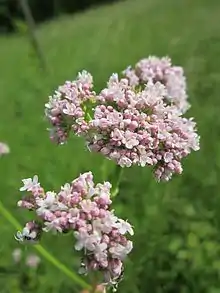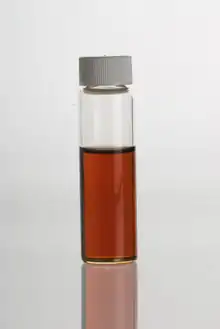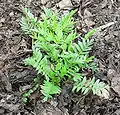Valerian (herb)
Valerian (Valeriana officinalis, Caprifoliaceae) is a perennial flowering plant native to Europe and Asia.[1] In the summer when the mature plant may have a height of 1.5 metres (5 ft), it bears sweetly scented pink or white flowers that attract many fly species, especially hoverflies of the genus Eristalis.[2] It is consumed as food by the larvae of some Lepidoptera (butterfly and moth) species, including the grey pug.
| Valerian | |
|---|---|
 | |
| Scientific classification | |
| Kingdom: | Plantae |
| Clade: | Tracheophytes |
| Clade: | Angiosperms |
| Clade: | Eudicots |
| Clade: | Asterids |
| Order: | Dipsacales |
| Family: | Caprifoliaceae |
| Genus: | Valeriana |
| Species: | V. officinalis |
| Binomial name | |
| Valeriana officinalis | |
Crude extract of valerian root may have sedative and anxiolytic effects, and is commonly sold in dietary supplement capsules to promote sleep.[1]
History
Valerian has been used as a medicinal herb since at least the time of ancient Greece and Rome. Hippocrates described its properties, and Galen later prescribed it as a remedy for insomnia. In medieval Sweden, it was sometimes placed in the wedding clothes of the groom to ward off the "envy" of the elves.[3] In the 16th century, the Anabaptist reformer Pilgram Marpeck prescribed valerian tea for a sick woman.[4]
John Gerard's Herball, first published in 1597, states that his contemporaries found Valerian "excellent for those burdened and for such as be troubled with croup and other like convulsions, and also for those that are bruised with falls." He says that the dried root was valued as a medicine by the poor in the north of England and the south of Scotland, so that "no broth or pottage or physicall meats be worth anything if Setewale [Valerian] be not there".[5][6]
The seventeenth century astrological botanist Nicholas Culpeper thought the plant was "under the influence of Mercury, and therefore hath a warming faculty." He recommended both herb and root, and said that "the root boiled with liquorice, raisons and aniseed is good for those troubled with cough. Also, it is of special value against the plague, the decoction thereof being drunk and the root smelled. The green herb being bruised and applied to the head taketh away pain and pricking thereof."[6]
Etymology and common names
The name of the herb is derived from the personal name Valeria and the Latin verb valere (to be strong, healthy).[7][8] Other names used for this plant include garden valerian (to distinguish it from other Valeriana species), garden heliotrope (although not related to Heliotropium), setwall and all-heal (which is also used for plants in the genus Stachys). Red valerian, often grown in gardens, is also sometimes referred to as "valerian", but is a different species (Centranthus ruber), from the same family but not very closely related.
Valerian extract
Biochemical composition
Known compounds detected in valerian include:
- Alkaloids: actinidine,[9] chatinine,[9][note 1] shyanthine,[9] valerianine,[9] and valerine[9]
- Isovaleramide may be created in the extraction process.[note 2]
- Gamma-aminobutyric acid (GABA)[1]
- Isovaleric acid[note 3]
- Iridoids, including valepotriates: isovaltrate and valtrate[9]
- Sesquiterpenes (contained in the volatile oil): valerenic acid,[12] hydroxyvalerenic acid and acetoxyvalerenic acid[13]
- Flavanones: hesperidin,[14] 6-methylapigenin,[14] and linarin[15]
Potential mechanism
Because of valerian's historical use in traditional medicine for diverse purposes, such as for sedation or pain relief, laboratory research has been directed at the GABAA receptor, a class of receptors on which benzodiazepines act.[16][17] Valeric acid which is responsible for the typical odor of mostly older valerian roots, does not have any sedative properties. Valproic acid, a widely prescribed anticonvulsant is a derivative of valeric acid.
Valerian also contains isovaltrate, which has been shown to be an inverse agonist for adenosine A1 receptor sites. This action likely does not contribute to the herb's possible sedative effects, which would be expected from an agonist, rather than an inverse agonist, at this particular binding site. Hydrophilic extractions of the herb commonly sold over the counter, however, probably do not contain significant amounts of isovaltrate.[18] Valerenic acid in valerian stimulates serotonin receptors as a partial agonist,[19] including 5-HT5A which is implicated in the sleep-wake cycle.[20]
Preparation
The chief constituent of valerian is a yellowish-green to brownish-yellow oil present in the dried root, varying in content from 0.5 to 2.0%. This variation in quantity may be determined by location; a dry, stony soil yields a root richer in oil than moist, fertile soil.[21] The volatile oils that form the active ingredient are pungent, somewhat reminiscent of well-matured cheese. Though some people remain partial to the earthy scent, others find it unpleasant, comparing the odor to that of unwashed feet.[22]
Traditional medicine

Although valerian is a common traditional medicine used for treating insomnia, there is no good evidence it is effective for this purpose.[23] Valerian has not been shown to be helpful in treating restless leg syndrome[24] or anxiety.[25]
The European Medicines Agency (EMA) approved the health claim that valerian can be used as a traditional herbal medicine to relieve mild nervous tension and to aid sleep; EMA stated that although there is insufficient evidence from clinical studies, its effectiveness as a dried extract is considered plausible.[26]
Oral forms

Oral forms are available in both standardized and unstandardized forms. Standardized products may be preferable considering the wide variation of the chemicals in the dried root, as noted above. When standardized, it is done so as a percentage of valerenic acid or valeric acid.
Adverse effects
Because the compounds in valerian produce central nervous system depression, they should not be used with other depressants, such as ethanol (drinking alcohol), benzodiazepines, barbiturates, opiates, kava, or antihistamine drugs.[27][28][29] Although no liver problems are normally encountered with valerian use, there have been case studies in which hepatotoxicity has been observed in apparently hypersensitive individuals following short-term use (e.g. one month).[30][31]
As an unregulated product, the concentration, contents, and potential contaminants in valerian preparations cannot be easily determined. Because of this uncertainty and the potential for toxicity in the fetus and hepatotoxicity in the mother, valerian use is discouraged during pregnancy.[27][28]
Effect on cats
Valerian root is a cat attractant in a way similar to catnip.[32]
Floral symmetry
Valerian is unusual in having flowers with "handedness", that is, having neither radial nor bilateral symmetry.[33]
Weed
Valerian is considered an invasive species in many jurisdictions, including the US state of Connecticut where it is officially banned,[34] and in New Brunswick, Canada where it is listed as a plant of concern.[35]
Image gallery
 V. officinalis flowers
V. officinalis flowers 19th-century illustration of Valeriana officinalis
19th-century illustration of Valeriana officinalis Illustration of V. officinalis from Atlas des plantes de France, 1891.
Illustration of V. officinalis from Atlas des plantes de France, 1891. V. officinalis
V. officinalis V. officinalis foliage
V. officinalis foliage
See also
Notes
- Although many sources list "catinine" as an alkaloid present in extracts from the root of Valeriana officinalis, those sources are incorrect. The correct spelling is "chatinine". It was discovered by S. Waliszewski in 1891. See: S. Waliszewski (15 March 1891) L'Union pharmaceutique, page 109. Abstracts of this article appeared in: "Chatinine, alcaloïde de la racine de valériane" Répertoire de pharmacie, series 3, vol. 3, pp. 166–167 Archived 2013-06-19 at the Wayback Machine (April 10, 1891) ; American Journal of Pharmacy, vol. 66, p. 285 Archived 2013-06-19 at the Wayback Machine (June 1891).
- Isovaleramide does not appear to be a naturally occurring component of valerian plants; rather, it seems to be an artifact of the extraction process; specifically, it is produced by treating aqueous extracts of valerian with ammonia.[10]
- Isovaleric acid does not appear to be a natural constituent of V. officinalis; rather, it is a breakdown product that is created during the extraction process or by enzymatic hydrolysis during (improper) storage.[11]
References
- "Valerian". Office of Dietary Supplements, US National Institutes of Health. 15 March 2013. Retrieved 2 April 2018.
- Van Der Kooi, C. J.; Pen, I.; Staal, M.; Stavenga, D. G.; Elzenga, J. T. M. (2015). "Competition for pollinators and intra-communal spectral dissimilarity of flowers". Plant Biology. 18 (1): 56–62. doi:10.1111/plb.12328. PMID 25754608. Archived (PDF) from the original on 2015-09-29.
- Thorpe, Benjamin (1851) Northern Mythology Archived 2013-04-16 at the Wayback Machine. Lumley. Vol. 2. pp. 64–65.
- Torsten Bergsten (1958). "Two Letters by Pilgram Marpeck". Mennonite Quarterly Review. 32: 200.
- Chisholm, Hugh, ed. (1911). . Encyclopædia Britannica. 27 (11th ed.). Cambridge University Press. p. 858.
- Grieve, Maud (1971). A Modern Herbal: The Medicinal, Culinary, Cosmetic and Economic Properties, Cultivation and Folk-lore of Herbs, Grasses, Fungi, Shrubs, & Trees with All Their Modern Scientific Uses, Volume 2.
- Harper, Douglas. "valerian". Online Etymology Dictionary.
- Latin definition for: valeo, valere, valui, valitus Archived 2014-03-28 at the Wayback Machine. latin-dictionary.net
- Fereidoon Shahidi and Marian Naczk, Phenolics in food and nutraceuticals (Boca Raton, Florida, USA: CRC Press, 2004), pp. 313–314 Archived 2013-06-24 at the Wayback Machine ISBN 1-58716-138-9.
- Balandrin, M. F.; Van Wagenen, B. C.; Cordell, G. A. (1995). "Valerian-derived sedative agents. II. Degradation of Valmane-derived valepotriates in ammoniated hydroalcoholic tinctures". Journal of Toxicology: Toxin Reviews. 14 (2): 88–252. doi:10.3109/15569549509097280.
- pp. 22 and 123 Archived 2013-06-19 at the Wayback Machine of Peter J. Houghton, Valerian: the genus Valeriana (Amsterdam, the Netherlands: Harwood Academic Press, 1997) ISBN 90-5702-170-6.
- Yuan CS, Mehendale S, Xiao Y, Aung HH, Xie JT, Ang-Lee MK (2004). "The gamma-aminobutyric acidergic effects of valerian and valerenic acid on rat brainstem neuronal activity". Anesth Analg. 98 (2): 353–8, table of contents. CiteSeerX 10.1.1.323.5518. doi:10.1213/01.ANE.0000096189.70405.A5. PMID 14742369. S2CID 14526474.
- Wills, R.B.H. & Shohet, D. (July 2009). "Changes in valerenic acids content of valerian root (Valeriana officinalis L. s.l.) during long-term storage". Food Chemistry. 115 (1): 250–253. doi:10.1016/j.foodchem.2008.12.011.
- Marder M, Viola H, Wasowski C, Fernández S, Medina JH, Paladini AC (2003). "6-methylapigenin and hesperidin: new valeriana flavonoids with activity on the CNS". Pharmacol Biochem Behav. 75 (3): 537–45. doi:10.1016/S0091-3057(03)00121-7. PMID 12895671. S2CID 37559366.
- Fernández S, Wasowski C, Paladini AC, Marder M (2004). "Sedative and sleep-enhancing properties of linarin, a flavonoid-isolated from Valeriana officinalis". Pharmacol Biochem Behav. 77 (2): 399–404. doi:10.1016/j.pbb.2003.12.003. PMID 14751470. S2CID 34347546.
- Holzl J, Godau P (1989). "Receptor binding studies with Valeriana officinalis on the benzodiazepine receptor". Planta Medica. 55 (7): 642. doi:10.1055/s-2006-962221.
- Mennini T, Bernasconi P, et al. (1993). "In vitro study in the interaction of extracts and pure compounds from Valerian officinalis roots with GABA, benzodiazepine and barbiturate receptors". Fitoterapia. 64: 291–300.
- Lacher, Svenja K.; Mayer, Ralf; Sichardt, Kathrin; Nieber, Karen; Müller, Christa E. (2007). "Interaction of valerian extracts of different polarity with adenosine receptors: Identification of isovaltrate as an inverse agonist at A1 receptors". Biochemical Pharmacology. 73 (2): 248–58. doi:10.1016/j.bcp.2006.09.029. PMID 17097622.
- Patočka, Jiří; Jakl, Jiří (2010). "Biomedically relevant chemical constituents of Valeriana officinalis". Journal of Applied Biomedicine. 8 (1): 11–18. doi:10.2478/v10136-009-0002-z.
- Dietz BM, Mahady GB, Pauli GF, Farnsworth NR (2005). "Valerian extract and valerenic acid are partial agonists of the 5-HT5a receptor in vitro". Brain Res. Mol. Brain Res. 138 (2): 191–7. doi:10.1016/j.molbrainres.2005.04.009. PMC 5805132. PMID 15921820.
- "Valerian". Botanical.com. Archived from the original on 2006-11-10. Retrieved 2007-04-15.
- Harrington, H.D., Edible Native Plants of the Rocky Mountains, The University of New Mexico Press, 1967, LCCN 67-29685, p. 225
- Leach MJ, Page AT (2015). "Herbal medicine for insomnia: A systematic review and meta-analysis". Sleep Med Rev (Review). 24: 1–12. doi:10.1016/j.smrv.2014.12.003. PMID 25644982.
- Bega D, Malkani R (2016). "Alternative treatment of restless legs syndrome: an overview of the evidence for mind-body interventions, lifestyle interventions, and neutraceuticals". Sleep Med. (Review). 17: 99–105. doi:10.1016/j.sleep.2015.09.009. PMID 26847981.
- Miyasaka LS, Atallah AN, Soares BG (2006). "Valerian for anxiety disorders". Cochrane Database Syst Rev (Systematic review) (4): CD004515. doi:10.1002/14651858.CD004515.pub2. PMID 17054208.
- "European Medicines Agency - Find medicine - Valerianae radix". www.ema.europa.eu. Archived from the original on 2016-08-17. Retrieved 2016-08-08.
- Klepser TB, Klepser ME (1999). "Unsafe and potentially safe herbal therapies". Am J Health-Syst Pharm. 56 (12538): 125–38, quiz 139–41. doi:10.1093/ajhp/56.2.125. PMID 10030529.
- Wong AH, Smith M, Boon HS (1998). "Herbal remedies in psychiatric practice". Arch Gen Psychiatry. 55 (103344): 1033–44. doi:10.1001/archpsyc.55.11.1033. PMID 9819073.
- Miller LG (1998). "Herbal medicines. Selected clinical considerations focusing on known or potential drug-herb interactions". Arch Intern Med. 158 (220011): 2200–11. doi:10.1001/archinte.158.20.2200. PMID 9818800.
- Daniel Cohen and Yanisa Toro (2008). "A Case of Valerian-associated Hepatotoxicity". Journal of Clinical Gastroenterology. 42 (8): 961–962. doi:10.1097/MCG.0b013e3180500348. PMID 18431248.CS1 maint: uses authors parameter (link)
- ThemistoklisVassiliadis at al. (2009). "Valeriana hepatotoxicity". Sleep Medicine. 10 (8): 935. doi:10.1016/j.sleep.2008.09.009. PMID 19138557.CS1 maint: uses authors parameter (link)
- Bol, Sebastiaan (16 March 2017). "Responsiveness of cats (Felidae) to silver vine (Actinidia polygama), Tatarian honeysuckle (Lonicera tatarica), valerian (Valeriana officinalis) and catnip (Nepeta cataria)". BMC Veterinary Research. 13 (1): 70. doi:10.1186/s12917-017-0987-6. PMC 5356310. PMID 28302120.
- Weberling, Focko (1992). Morphology of Flowers and Inflorescences. Cambridge University Press. p. 19. ISBN 0-521-25134-6.
- "USDA PLANTS Database – Connecticut State-listed Noxious Weeds". Archived from the original on 2014-06-26.
- New Brunswick Invasive Species Council (2012). Field Guide to 12 Invasive Plants of Concern in New Brunswick (PDF). Archived from the original on 2013-10-26.CS1 maint: bot: original URL status unknown (link)